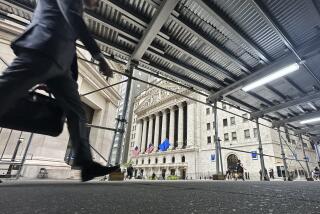Wall Street reacts to economic storm clouds
- Share via
Reporting from New York — Wall Street gave its response to the historic U.S. debt downgrade — run for cover.
In market chaos reminiscent of the 2008 financial crisis, nervous investors headed for the exits in droves, many looking for a safer place to put their money.
The Dow Jones industrial average plunged 634.76 points, or 5.6%, to 10,809.85 on the first day of trading since the U.S. lost its AAA rating from Standard & Poor’s. It was the worst single day of trading since Dec. 1, 2008, when the U.S. was embroiled in economic turmoil.
Investors anxiously looked forward to the beginning of the Federal Reserve’s meeting Tuesday, when the central bank could announce moves to support the fragile economy. But after nearly two weeks of falling stock prices, optimism was wearing thin.
Trading floors across Wall Street buzzed with activity Monday as investors tried to come to terms with how much further down the markets could go. The volume of stock trading was at its highest level since the “flash crash” on May 6, 2010, and nearly everyone was trying to sell.
“You had the sense all day long that it was just pure frustration,” said Joe Mazzella, chief market strategist for Knight Capital Group. “People are just saying, ‘Enough, I can’t take it anymore.’”
With its downgrade, Standard & Poor’s called into question the United States’ ability to pay back its creditors, but Treasury bonds were one of the few desirable assets Monday as investors continued to view them as a haven.
Market experts said that the downgrade announcement served less as an indicator of the United States’ credit quality than a reminder of the gathering storm clouds that suggest a global economic slowdown.
“It’s really very striking that stocks are going down while Treasuries are going up,” said Paul Dales, an economist with Capital Economics. “That tells me that it’s not about the downgrade. There are just concerns about the economic outlook.”
Traders expected a dramatic opening Monday after S&P made its announcement late Friday.
The European Central Bank tried to calm markets by announcing a program Sunday night to buy the bonds of troubled member nations, but it provided little comfort. Leading indexes fell 5% in Germany and 4.7% in France.
Stock prices in the U.S. headed down steeply immediately after the opening bell and rarely looked back, suggesting that a good dose of the declines may have been due to self-perpetuating investor fear, which has built over the last two weeks of declining stock prices.
Some analysts saw the panicked selling as a hopeful sign that provides an opening for more level-headed investors to begin buying stocks to lead the market back up.
“Today has the markings of somewhat of a market low that we can build off of,” Mazzella said.
Along with Treasuries, gold was one of the few assets that investors sought out Monday, driving the precious metal up 3.7% to a new record of $1,710 an ounce.
The broader Standard & Poor’s 500 index ended the day down 6.7%, or 79.92 points, to 1119.46. The Nasdaq composite index fell 6.9%, or 174.72 points, to 2357.69.
More to Read
Inside the business of entertainment
The Wide Shot brings you news, analysis and insights on everything from streaming wars to production — and what it all means for the future.
You may occasionally receive promotional content from the Los Angeles Times.










